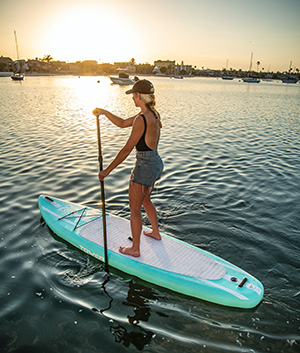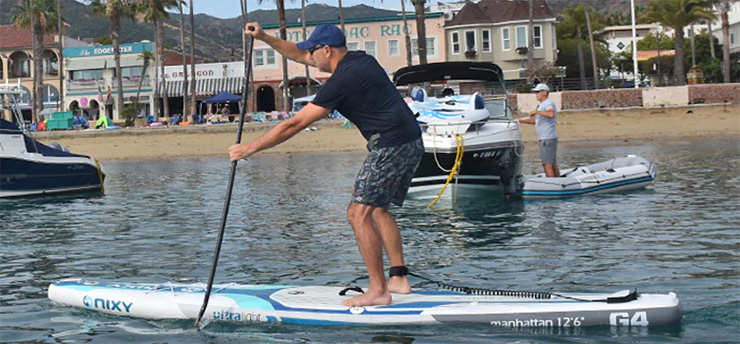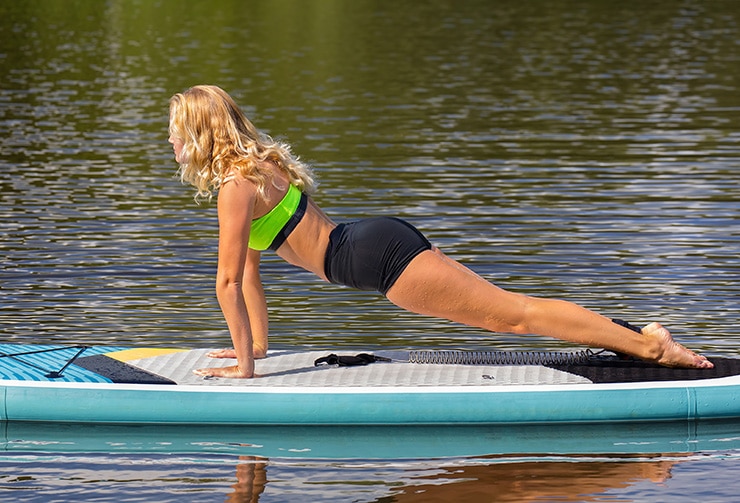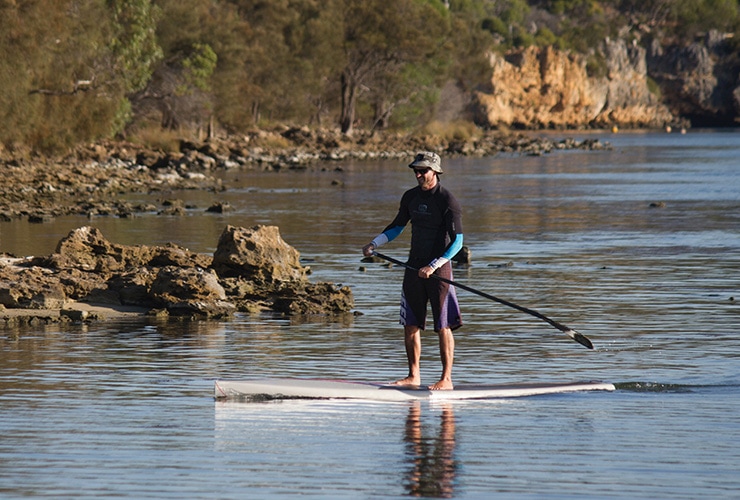Stand up paddle boarding is a fun, low-impact exercise that you can enjoy with your buddies or family and is great for keeping your fit. But did you know that it offers a ton of other benefits too?
While it may look easy, relaxing and low-effort, paddle boarding can actually have life-changing positive effects on your health, both mentally and physically. Plus, it’s good for your social life too!
12 Fantastic Benefits of SUP Boarding
The great thing about SUP is that it’s a full-body workout that will leave you feeling healthier all around. So let’s take a look at some of the top, proven benefits of paddle boarding.
1. Paddle Boarding Burns a Lot of Calories
While SUP doesn’t look challenging from a distance, it burns more calories than most common activities.
According to the Captain Calorie Calculator, the average person can expect to burn anywhere from 400 to 550 calories in an hour of SUP.

The number of calories you burn may be higher or lower, depending on your weight and the kind of SUP activity you’ll be doing.
For instance, a 150-pound paddler will burn roughly 430 calories per hour of paddle boarding. Those are a lot of calories!
In contrast, the same person will only burn about 358 calories while running at a speed of 4 miles per hour. They also would only use 379 calories walking uphill!
Remember, we’re only talking about the easier SUP activities like SUP yoga and recreational paddling. You’ll burn more calories with the more intense paddle boarding activities.
You can burn anywhere from 600 to 750 calories per hour of SUP surfing and 600 to 700 calories with SUP touring. Paddle board racing burns the most numbers of calories–from roughly 715 to 1130 calories.
Not many physical activities can match this. It can help you shed those excess pounds while having fun.
2. Paddle Boarding Reduces Stress and Improves Your Mental Health
Your mental health affects pretty much every area of your life. It affects how you interact with your loved ones, your productivity at work, your physical health, and your general well-being. So better mental health directly translates to a better life.
Stand up paddle boarding can have a positive impact on your mental health in multiple ways. First, it allows you to unplug from electronic devices and your busy day-to-day life. If you have a stressful situation going on you can escape for a couple of hours and take time to reorganize your thoughts.
According to this National Library of Medicine journal, physical exercise (which includes SUP) improves your mood, relieves stress, lowers anxiety, and alleviates depression. It also improves your self-esteem and helps you sleep better.
Lastly, paddle boarding is done outside, where you’re surrounded by nature. Some studies suggest that being in and around nature can reduce feelings of anger and stress, in addition to boosting your mood.
So if you want stress relief, pick up your paddle board and head to the nearest body of water. It might just be what you need.
3. SUP Lowers Risk of Cardiovascular Disease
Stand up paddle boarding, like other physical exercises, plays a key role in reducing your risk of heart disease.
This John Hopkins Medicine article asserts that maintaining a regular exercise routine could help lower your blood pressure, lower your heart rate, and increase the level of “good” cholesterol.
Regular SUP sessions could improve your cardiovascular health and reduce the risk of a sudden heart attack. And this isn’t hard to do because paddle boarding is fun and versatile.

4. Paddle Boarding Works Almost Every Muscle Group
Don’t be fooled by how simple SUP looks from a distance. It may seem like the arms are doing all the work but paddle boarding actually involves the entire body. In fact, it’s one of the best full-body workouts out there.
The muscles on your upper body–your back, shoulder, and arm muscles–are all involved in making a paddle stroke. Using the big muscle groups instead of just your arms ensures that your stroke has more power. It also prevents you from getting worn out quickly.
Your core muscles are also engaged the entire time. Your leg muscles and glutes aren’t left out too–as you try to maintain balance and make a proper paddle stroke. If you’re new to SUP, you’ll certainly feel the effects the following day.
Besides the large muscles, stand up paddle boarding also engages your neck, fingers, feet, and other smaller muscles. So your whole body is involved.
5. Practicing SUP is an Amazing Core Workout
There are numerous benefits that come with exercising your core. In addition to having great abs, you’ll have better balance and find it easier to do most physical activities. A strong core helps with back pain too.
Maintaining balance on a SUP on the water is a lot of work and your core plays a huge role in this job. This makes paddle boarding a great core workout; it’s a fantastic way for you to build core strength and tone your abs.
6. SUP Gives You a Break from Sitting
You’ll probably be aware that, in the developed world, we spend way too much time sitting–at the office working long hours, on the couch binging our favorite shows, etc.
Experts have expressed that sitting for long hours is harmful. Some of them have gone as far as to say that sitting is the new smoking. It could lead to high cholesterol levels, increased blood sugar, obesity, and maybe even death.
Adding a standing activity to your routine will do you a lot of good. And I can’t think of one better than stand up paddle boarding. You can easily paddle board for hours, significantly reducing the amount of time you spend sitting.

7. Stand Up Paddle Boarding Improves Your Posture
Most activities that consume our day-to-day lives are slowly hurting us by compromising our posture. We spend many hours hunched over our office desks or phones. Add to this the fact that we sit pretty much all day.
Stand up paddle boarding strengthens your core–and a strong core translates to better posture. It also helps you take a break from sitting and staring down at your phone which means less straining of your spine and neck.
8. Paddle Boarding Improves Your Balance
Anyone who has paddled before will tell you that attaining and maintaining balance can be one of the more challenging parts of SUP. The paddle board surface is small and standing on a a floating board is obviously not as stable as standing on the ground. Even the wide beginner paddle boards can require some getting used to.
So SUP is all about balance. Learning to stay upright on a paddle board will greatly improve your balance in other areas of your life.
If you’re a professional athlete looking for a good workout to add to your cross-training schedule, then paddle boarding is a wonderful option. Every athlete could benefit from better balance.

9. SUP is Gentle on Your Joints
Stand up paddle boarding is a low-impact workout, unlike activities like running. It doesn’t strain your joints or tendons. This is fantastic, given all the numerous health benefits that come with SUP.
Anyone can paddle board, regardless of age and fitness level. A gentle activity like SUP boarding is also ideal for injured athletes who want to exercise without causing themselves further harm.
10. SUP Gets You Outside for Vitamin D
Lack of vitamin D in your body can lead to a lot of problems, including soft bones, muscle weakness, fatigue, and depression.
The sun is one of the best sources of vitamin D–and it’s free! But just going out to sit in the sun doesn’t sound interesting and it gets old pretty quickly. With stand up paddle boarding, you get to exercise, have fun, and acquire vitamin D in the process.
Besides, spending more time outside is easier when you have something to do.
11. SUP Boarding Is Versatile
In my opinion, one of the best things about SUP is that it never gets boring. There are so many activities you can incorporate into your paddle boarding sessions to make them more exciting!
If you’re tired of paddling around leisurely, you can start doing yoga mid-session. This will greatly improve your core and leg strength and it’s also amazing for your mental health.
Alternatively, you can attach some fishing rod holders to your SUP board and try fishing. Casting while on a SUP board adds a little challenge to paddle boarding because it’s harder to maintain balance while moving around.
You could also try paddle board racing or maybe paddle surfing where you catch waves with your board. These are more intense activities and they burn more calories. They are great if you’re looking to lose weight.
12. You’ll Make More Friends with Paddle Boarding!
The paddling community is growing by the day, all over the world. There are tons of SUP groups pretty much everywhere, online and offline. If you just moved to a new place and are looking for friends, or you just want to expand your social life, you can pick up paddle boarding.
You’ll meet many friendly faces who will love hanging out in the water with you. Besides, most of these groups host competitions and events which are a whole lot of fun. This is also a great way to get into professional paddle boarding if you’re interested.
Conclusion
The benefits of stand up paddle boarding are numerous–from health benefits, physical benefits, and mental benefits, to social benefits.
Paddle boarding helps with mental health and it’s effective in managing stress levels. It also burns many calories and it would make a wonderful weight loss exercise.
SUP may seem simple from a distance but it’s a full-body workout that targets most muscles in your body. It can improve your cardiovascular health too.
Lastly, paddle boarding is a low-impact exercise and it’s an ideal recreational activity even for people with joint problems.
So get out there and paddle!

